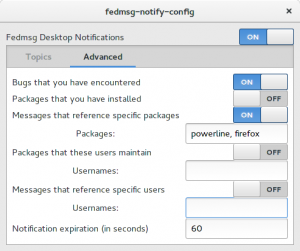Have you updated your Fedora system recently? Hopefully you do this regularly. Updates fix various bugs and even add new features to your most loved applications. An update, to our users, is generally a notification from the Software application. If you’re an advanced user and prefer the command line, the process is simple:
Where updates come from
But behind the scenes, there’s quite a lot of work done before the updated package reaches the end user. In short, this is the workflow:
- The application developer releases an update.
- The package maintainer notices the new release.
- The package maintainer builds new packages for the various Fedora versions using the Koji build system.
- The package maintainer pushes an update to the updates-testing repository using the Bodhi updates system.
- The Fedora QA contributors test updates and give them karma on Bodhi.
- When the new update is verified, it is pushed to end users via the updates repository.
This process, as you see above, uses various tools to help package maintainers do their work, and in turn, get packages to end users more quickly.
Most Fedora package maintainers maintain multiple packages. Often they do their work in their personal, spare time. So the Fedora Infrastructure team does its best to help them easily keep an eye on new upstream releases. The Infrastructure team develops, deploys and maintains all of these apps, including an upstream monitoring application.
Introducing Anitya
They also have a really cool Upstream Monitoring System in place called Anitya. Once package maintainers add their packages to Anitya, it notifies them when a new version is available by filing a bug in Bugzilla.
Anitya doesn’t stop there; it also downloads the new version and tries to run a test build. It then leaves a message in the Bugzilla bug to tell the maintainer if the new release is a simple update. This helps package maintainers, who’d otherwise need to manually keep tabs on all the software they maintain in Fedora.
But you don’t have to scour Bugzilla to find this news. Say you’re interested in receiving package news at your desktop, such as a new upstream release or a package in the updates-testing repository. You can get notifications at your desktop, using the same messaging bus as Fedora’s web applications. The messaging bus allows those apps to communicate with each other, but it’s public so anyone can listen to its messages.
Upstream monitoring at your desktop
First, install the fedmsg-notify package. You can search for fedmsg in the Software application, or run this command:
sudo dnf install fedmsg-notify
Once you have the application installed, launch the configuration tool. Search for fedmsg using the GNOME Shell search, or run it from the command line:
fedmsg-notify-config
Under the Advanced tab, you can select specific packages to watch for on the messaging bus:
When a message hits the bus concerning one of the selected packages, you’ll see a notification on your desktop. Most notifications have a link to take you directly to the details.
Needless to say, the Fedora community is fortunate to have such an amazing infrastructure team always looking to improve the tools that Fedora depends on. If you’d like to join them, take a look at their wiki page here.
Cover Image based on Mountain And River Low Poly CC-BY-3.0 by HUB3RT28







Sudhir Khanger
Anitya, Adwaita, Bodhi, etc. someone is into Eastern mysticism.
Stephen Kawamoto
All of the server names are Hindu philosophy regarding life, its relationship to fate be destiny, and striving for perfection/peace of mind. They are only mystical to Westerners, who tend to complicate their understanding of Eastern philosophy.
Ymmv
Sam
Where updates come from
Upstream application developer and community put in lots of work before releasing an update.